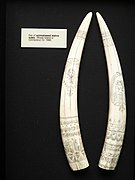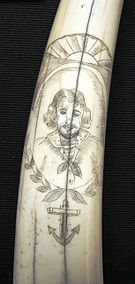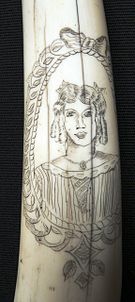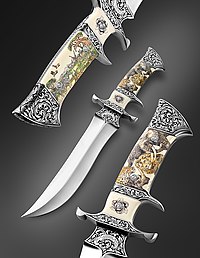Did Doyle Yancey Make Scrimshaw Out Of Real Animal Ivory Or Is His Work - Buckles Made From Plastic

American whaling ships, scrimshaw on whale tooth, c. 1800
Scrimshaw is scrollwork, engravings, and carvings washed in bone or ivory. Typically it refers to the artwork created past whalers, engraved on the byproducts of whales, such as bones or cartilage. It is about normally made out of the bones and teeth of sperm whales, the baleen of other whales, and the tusks of walruses. It takes the form of elaborate engravings in the class of pictures and lettering on the surface of the os or tooth, with the engraving highlighted using a paint, or, less ofttimes, small sculptures fabricated from the aforementioned material. However, the latter actually fall into the categories of ivory carving, for all carved teeth and tusks, or bone etching. The making of scrimshaw probably began on whaling ships in the late 18th century and survived until the ban on commercial whaling. The practice survives as a hobby and every bit a trade for commercial artisans. A maker of scrimshaw is known as a scrimshander.[1] The word start appeared in the logbook of the brig By Gamble in 1826,[2] simply the etymology is uncertain.[iii]
History and materials [edit]


Pair of walrus tusks depicting a crewman and a adult female. Rhode Island or Connecticut, circa 1900



Scrimshaw is derived from the exercise of sailors on whaling ships creating common tools, where the byproducts of whales were readily bachelor. The term originally referred to the making of these tools, only later referring to works of fine art created by whalers in their spare time. Whale os was ideally suited for the chore, every bit it is easy to work and was plentiful.
The widespread carving of scrimshaw became possible later the 1815 publication of the journal of U.S. Navy Captain David Porter exposed both the marketplace and the source of the whale teeth, causing a surplus of whale teeth that profoundly diminished their value and made them bachelor as a fabric for ordinary seamen.[four] Effectually this time is the earliest authenticated pictorial piece of sperm whale scrimshaw (1817). The tooth was inscribed: "This is the molar of a sperm whale that was caught near the Galápagos Islands by the crew of the ship Adam [of London], and made 100 barrels of oil in the year 1817."[five]
Other sea creature ivories were also used equally alternatives for rarer whale teeth. Walrus tusks, for instance, may have been caused in trade from indigenous walrus hunters.
Scrimshaw essentially was a leisure activity for whalers. Because the work of whaling was very unsafe at the all-time of times, whalers were unable to work at dark. This gave them a great deal more free fourth dimension than other sailors. A lot of scrimshaw was never signed, and a great many of the pieces are bearding. Early scrimshaw was done with rough sailing needles, and the movement of the send, as well every bit the skill of the artist, produced drawings of varying levels of item and artistry. Originally, candle black, soot or tobacco juice would have been used to bring the etched pattern into view. Also, ink was used that the sailors would bring on before the voyage. Today's artists utilise finer tools in various sizes, mostly borrowed from the dental industry. Some scrimshanders ink their work with more than one color, and restrained polychromed examples of this art are at present pop.
Originating in an era when sperm whales were initially plentiful only to be hunted to near collapse, scrimshaw no longer is an artform utilizing an easily renewable creature resource, only 1 that is susceptible to contraband. Now, the Endangered Species Act and international conventions restrict the harvest and sale of ivory, in endeavor to opposite the scarcity of ivory-begetting animals.
- Though there are sources of ivory that are sanctioned and legal, poachers in Africa and other continents where elephants are an endangered species still kill for their ivory, Elephant ivory has been regulated since 1976 by the Convention on International Trade in Endangered Species and selling African ivory has been prohibited since 1989.
- 19th and 20th century scrimshaw, scrimshaw crafted earlier 1989 (elephant) or before 1973 (sperm whale ivory, walrus ivory etc.) is legal. It is prohibited after that yr for commercial import in the U.Due south. under the Marine Mammal Protection Act.
- Additionally, walrus tusks bearing the Alaska State walrus ivory registration tag, and mail-police walrus ivory that has been carved or scrimshawed by an indigenous Alaskan, is legally available.
- Finally, any ivory considered ancient, such as 10,000- to 40,000-year-erstwhile mammoth ivory, is completely unrestricted in its auction or possession.
Scrimshanders and collectors acquire legal whale teeth and marine tusks through estate sales, auctions and antiquarian dealers. To avert illegal ivory, collectors and artists bank check provenance and deal only with other established and reputable dealers. Scrimshaw that is establish to accept been illegally sourced may be seized past customs officials worldwide, dramatically loses value and is very hard to re-sell, as the express channels through which collectible scrimshaw passes serves as a check on unscrupulous persons. As with any other fine fine art form, it is usually possible for experienced museums, auction houses or other experts to perceive a fake.
Scrimshaw can as well exist iii-dimensional artifacts that are mitt carved by the scrimshander. They carved useful tools such every bit a jagging wheel. The jagging wheel is a multi-purpose tool used to pierce and trim a pie crust. Corset busks were carved from bone or ivory.
Care and preservation [edit]
Ivory is a frail medium; many 19th-century pieces were preserved considering they were kept in a barrel of oil on board ship. Gary Kiracofe, a scrimshander in Nantucket, Massachusetts, advises collectors that if a slice looks dry, 1 should fill the center of the tooth with unscented baby oil and allow it to remain until as much oil equally possible is soaked into the microscopic pores of the ivory.[ citation needed ] Clear paste wax or high-end motorcar wax will seal the surface subsequently oiling. Bone items are even more than fragile (more fibrous and porous) and may be treated the same way: with a lite articulate mineral oil. Organic oils are inadvisable, as they will eventually hasten discoloration, as on old pianoforte keys subjected to the natural oils in one's hands.
Professional conservators of art and celebrated artifacts generally recommend confronting applying whatsoever blazon of dressing (like oil or wax) to organic objects such every bit whale ivory. Sensible choices regarding storage and display preserve whale ivory best: keep out of directly sunlight, handle with cotton gloves or freshly washed hands, and avoid keeping in places with shifting humidity and temperature. Blanket organic objects tin induce eventual cracking.
Design [edit]
Whale teeth and bones were a highly variable medium, used to produce both practical pieces, such as paw tools, toys and kitchen utensils, and highly decorative pieces, which were purely ornamental. The designs on the pieces varied greatly every bit well, though they oftentimes had whaling scenes on them. For example, Herman Melville, in Moby-Dick, refers to "lively sketches of whales and whaling-scenes, graven by the fishermen themselves on Sperm Whale-teeth, or ladies' busks wrought out of the Right Whale-bone, and other skrimshander manufactures".[vi] Nigh engravings were adjusted from books and papers.[ citation needed ]
Collections [edit]
A significant amount of the original scrimshaw created by whalers is currently held past museums.[ citation needed ] Museums with significant collections include:
- The Hull Maritime Museum in Kingston upon Hull, England
- The Kendall Whaling Museum, which is part of the New Bedford Whaling Museum in New Bedford, Massachusetts
- The Scott Polar Enquiry Constitute in Cambridge, England[7]
- The Scrimshaw Museum at the Peter Café Sport in Horta on the island of Faial in the Azores
- The Nantucket Whaling Museum
- The Mariners' Museum in Newport News, Virginia
Other images of scrimshaw tin be found at:
- The Museum of New Zealand Te Papa Tongarewa
- Ripley's Museum Niagara Falls – Scrimshaw piano key fine art
- Ripley's Museum Baltimore – Scrimshaw pianoforte key art
- DaVinci exhibit – earth travelling exhibit – Scrimshaw piano key art
-

Detail on a piece in the Horta Scrimshaw Museum
-

A small collection of scrimshaw, Smithsonian Scrimshaw Drove
Modern scrimshaw [edit]

Example of modernistic scrimshaw by artist Edmund Davidson
While scrimshaw is rarely washed on whale bone these days, information technology is still adept by a few artists. Common modern materials are micarta, ivory (elephant, fossil, walrus), hippo tusk, warthog ivory, buffalo horn, giraffe bone, mother of pearl, and camel bone. Modernistic scrimshaw typically retains the nautical themes of historical scrimshaw, but tin also go well outside of the traditional.
Today's trade and carving techniques have led to more than avant-garde, but not as unique scrimshaw carvings. Collectors are advised to exist aware of fakes.[eight]
See also [edit]
- Chip piece of work - glassware, engraved in a like way
- Bone carving
References [edit]
Notes [edit]
- ^ "scrimshander". Merriam-Webster.com. 2015. Archived from the original on 2007-09-30. Retrieved 2015-08-26 .
- ^ Logbook of the brig By Chance, held at the New Bedford Whaling Museum (call number KWM #35A, Reel 3)
- ^ Morris, Evan (April xix, 2010). "Scrimshaw, A long time to exist gone". The Give-and-take Detective . Retrieved 2015-08-26 . And see Stephen Goranson's 2009 post to the American Dialect Society, "scrimshaw: proposed etymology".
- ^ Wertkin, Gerard C. (2004). Encyclopedia of American Folk Art . Routledge. p. 530. ISBN978-1-135-95615-8.
- ^ Perrin, William F.; Wursig, Bernd; Thewissen, J.Thousand.M. 'Hans', eds. (2009). Encyclopedia of Marine Mammals. Bookish Press. p. 995. ISBN978-0-08-091993-5.
- ^ Melville, Herman. "57: Of Whales in Paint; in Teeth; in Wood; in Sheet-Fe; in Rock; in Mountains; in Stars". Moby Dick; or, The Whale . Retrieved 2015-08-26 – via American Literature, Classic Books and Curt Stories.
- ^ "Scrimshaw Collection at the Scott Polar Research Institute". University of Cambridge. Retrieved 2015-08-26 .
- ^ Ronald C. Reece, PhD, "Ron'south Republic of cote d'ivoire"
Further reading [edit]
- Stevens, Jim (2008). Scrimshaw Techniques, History, Gallery, Equipment, Types of Ivory, Alternative Materials, Cutting, Sanding, Polishing, Creating Images, Inlays and Basing, Scrimshaw Techniques and Inking, Pub: Schiffer Publishing, ISBN 978-0-7643-2831-2
- Stevens, Jim (2008). Advanced Scrimshaw Techniques, Types of Ivory, Alternative Materials, Colour Techniques, Power Scrimshaw, Carving, Imitations and Fakes, Repair, Conservation, Restoration, Glossary, Pub: Schiffer Publishing, ISBN 978-0-7643-3017-9
- Stevens, Jim (2010). Powder Horns: Fabrication & Decoration, Pulverization horn working, shaping, decorating, and finishing techniques. Celebrated and modern tools illustrate inlays, engrailing, and how to scrimshaw pulverisation horns. Pub: Schiffer Publishing, ISBN 978-0-7643-3017-9
- Halat, Eva (2006). Gimmicky Scrimshaw. Verlag Angelika Hörnig. ISBN3-9808743-8-9.
External links [edit]
| | Wikimedia Eatables has media related to Scrimshaw. |
| | Await up scrimshaw in Wiktionary, the gratis dictionary. |
- Nantucket Historical Association Artifacts Online database
- Whaling depicted in scrimshaw and the art in ship logbooks
Source: https://en.wikipedia.org/wiki/Scrimshaw
Posted by: hydesith1974.blogspot.com

0 Response to "Did Doyle Yancey Make Scrimshaw Out Of Real Animal Ivory Or Is His Work - Buckles Made From Plastic"
Post a Comment